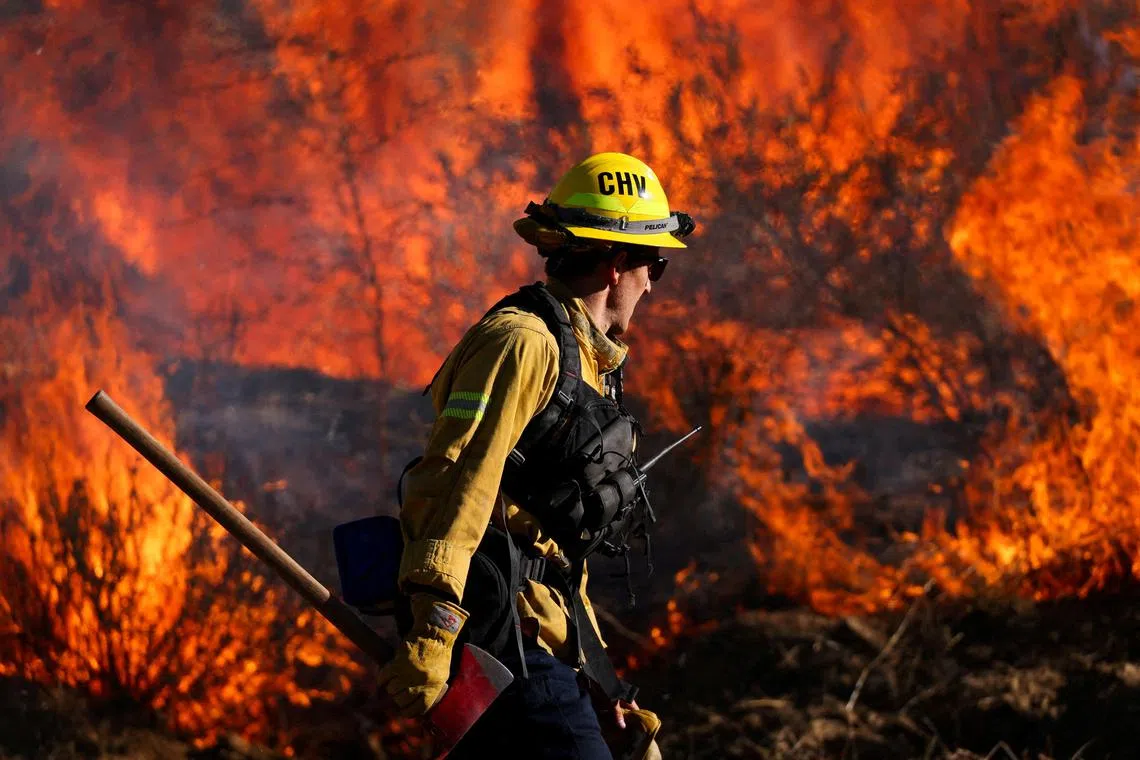Heat and wildfire smoke even more harmful when combined, study finds
Sign up now: Get ST's newsletters delivered to your inbox

As humans warm the planet, both heatwaves and wildfires are becoming more severe and longer-lasting in the American West.
PHOTO: REUTERS
Follow topic:
SAN DIEGO, California – In California, days that experienced both extreme heat and wildfire smoke at the same time have seen disproportionate numbers of hospitalisations for heart and lung ailments, according to a new study.
The research highlights the public health dangers of distinct climate threats that can have a compound effect when they occur simultaneously.
The research, published on Feb 2 in the journal Science Advances, also found that this compounding effect was greater in communities with lower levels of income, education, health insurance coverage and tree cover.
The background: Global warming intensifies both threats
As humans warm the planet, both heatwaves and wildfires are becoming more severe and longer-lasting in the American West. This also means they are more likely to overlap.
Researchers have estimated that two-thirds of California’s land area experienced broiling heat and heavy wildfire smoke concurrently at some point during the state’s record fire year of 2020.
Both hazards are harmful to health on their own: Heat stress increases cardiac strain, and inhaling wildfire smoke can aggravate lung conditions. The new study – led by researchers at the Scripps Institution of Oceanography at the University of California, San Diego – looked at the health effects when the two threats appeared in tandem.
On exceptionally hot and smoky days, staying indoors does not always help, and certainly not for people who do not have air-conditioners and air purifiers, said Dr Tarik Benmarhnia, an environmental public health researcher at Scripps and one of the study’s authors.
“Air pollution doesn’t stay politely outside,” he said. “It gets inside, interacts with a lot of indoor air pollutants and can lead to a lot of issues.”
The findings: Compounding harms, and unequal ones, too
The researchers took state data on unscheduled hospitalisations between 2006 and 2019 and combined it with detailed readings of temperatures and wildfire smoke.
They found that combined exposure to the two hazards had a bigger effect on hospitalisations than the sum of the effects from each separately. In other words, the harm to health from concurrent heat and smoke was greater than the sum of its parts.
California’s agricultural heartland, the Central Valley, and its wooded far north experienced more of these hot and smoky days than other regions during the study period, the researchers found.
They also found that the size of the compounding effect from heat and smoke varied across communities with different demographics. Areas with weaker socio-economic indicators and higher proportions of non-white residents had it worse.
What might be next: Joint warnings for heat and smoke
In California, heat advisories come from local offices of the National Weather Service, while hazardous air warnings are issued by local air quality management districts. The study’s findings suggest a joint heat and smoke warning would help keep more people safe, Dr Benmarhnia said.
To account for the extra danger on sweltering days, officials might also consider issuing air quality alerts even when pollution has not reached the level that would trigger a warning on cooler days, he added.
A spokesperson for California’s Air Resources Board said the agency was preparing new educational resources in 2024 to help residents protect themselves from concurrent heat and smoke.
“These types of joint events are just going to happen more and more,” Dr Benmarhnia said. NYTIMES

